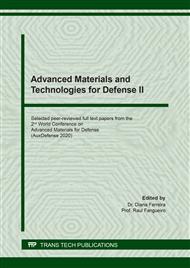[1]
J. Owens, Key elements of protection for military textiles, in: N. Pan, G. Sun (Eds.), Functional Textiles for Improved Performance, Protection and Health, Woodhead Publishing Limited, Cambridge, 2011, pp.249-268.
DOI: 10.1533/9780857092878.249
Google Scholar
[2]
D.H., Vu, J. Krejčí, Evaluating of temperature difference between target and background using measurement and simulation, International Conference on Military Technologies. (2017) 16–21.
DOI: 10.1109/miltechs.2017.7988723
Google Scholar
[3]
L. Fourt, N. Hollies, Factors involved in the study of clothing, in: Clothing: Comfort and Function, Marcel Dekker Inc., New York, 1970, pp.1-30.
Google Scholar
[4]
G. Havenith, Clothing and thermoregulation, in: Textiles and the Skin, Karger, Switzerland, 2003, pp.35-49.
Google Scholar
[5]
V. Rubežienė, I. Padleckienė, S. Varnaitė-Žuravliova, J. Baltušnikaitė, Reduction of thermal signature using fabrics with conductive additives, Materials Science (Medžiagotyra). 19 (2013) 409-414.
DOI: 10.5755/j01.ms.19.4.1730
Google Scholar
[6]
R. Kumar, A. Agarwal, S. Ramakrishna, Development of a metamaterial structure for large-area surfaces with specified infrared emissivity, Optical Engineering. 57 (2018) 087109.
DOI: 10.1117/1.oe.57.8.087109
Google Scholar
[7]
Y. Li, X. Bai, T. Yang, H. Luo, C.-W. Qiu, Structured thermal surface for radiative camouflage, Nature Communications. 9 (2018) 1–7.
DOI: 10.1038/s41467-017-02678-8
Google Scholar
[8]
D. Nguyen, H. Xu, Y. Zhang, B. Zhang, Active thermal cloak, Applied Physics Letters, 107 (2015) 121901.
DOI: 10.1063/1.4930989
Google Scholar
[9]
T. Han, X. Bai, J. Thong, B. Li, C.-W. Qiu, Full control and manipulation of heat signatures: cloaking, camouflage and thermal metamaterials, Advanced Materials. 26 (2014) 1731-1734.
DOI: 10.1002/adma.201304448
Google Scholar
[10]
R. Hu, S. Zhou, Y. Li, D.-Y. Lei, X. Luo, C.-W. Qiu, Illusion thermotics, Advanced Materials. 30 (2018) 1707237.
DOI: 10.1002/adma.201707237
Google Scholar
[11]
T. Z. Yang, Y. Su, W. Xu, X. D. Yang, Transient thermal camouflage and heat signature control, Applied Physics Letters. 109 (2016) 121905.
DOI: 10.1063/1.4963095
Google Scholar
[12]
S. Zhou, R. Hu, X. Luo, Thermal illusion with twinborn-like heat signatures, International Journal of Heat and Mass Transfer. 127 (2018) 607-613.
DOI: 10.1016/j.ijheatmasstransfer.2018.07.034
Google Scholar
[13]
J. Baumbach, Colour and camouflage: design issues in military clothing, in: E. Sparks (Ed.), Advances in Military Textiles and Personnel Equipment, Woodhead Publishing Limited, Cambridge, 2012, pp.79-102.
DOI: 10.1533/9780857095572.1.79
Google Scholar
[14]
R. A. Scott, Textiles in defence, in: Handbook of Technical Textiles, Woodhead Publishing Limited, Cambridge, 2000, pp.425-460.
Google Scholar
[15]
O. Salihoglu, H.B. Uzlu, O. Yakar, S. Aas, O. Balci, N. Kakenov, S. Balci, S. Olcum, S. Süzer, C. Kocabas, Graphene-based adaptive thermal camouflage, Nano Letters. 18 (2018) 4541-4548.
DOI: 10.1021/acs.nanolett.8b01746
Google Scholar
[16]
M. J. Moghimi, G. Lin, H. Jiang, Highly absorptive nanophotonic structures on flexible substrates for infrared camouflage, International Conference on Nano/Micro Engineered and Molecular Systems. 5 (2017) 21-24.
DOI: 10.1109/nems.2017.8016965
Google Scholar
[17]
C. Pimenta, C. Morais, R. Fangueiro, The thermal colour and the emissivity of printed pigments on knitted fabrics for application in diurnal thermal camouflage garment, Key Engineering Materials. 812 (2019) 127-133.
DOI: 10.4028/www.scientific.net/kem.812.127
Google Scholar
[18]
C. Pimenta, C. Morais, R. Fangueiro, The behavior of textile materials in thermal camouflage, Textiles Identity and Innovation: in Touch. (2020) 281-287.
DOI: 10.1201/9780429286872-43
Google Scholar


